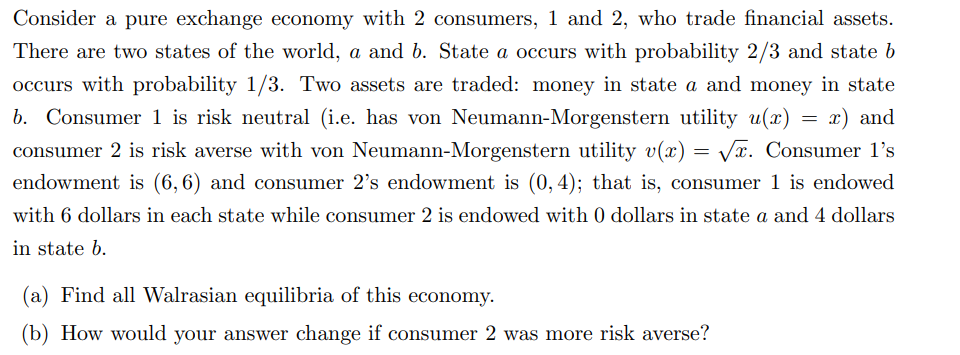Consider a pure exchange economy with 2 consumers, 1 and 2, who trade financial assets. There are two states of the world, a and b. State a occurs with probability 2/3 and state b occurs with probability 1/3. Two assets are traded: money in state a and money in state b. Consumer 1 is risk neutral (i.e. has von Neumann-Morgenstern utility u(x) x) and consumer 2 is risk averse with von Neumann-Morgenstern utility v(x) = √√√x. Consumer 1's endowment is (6,6) and consumer 2's endowment is (0, 4); that is, consumer 1 is endowed with 6 dollars in each state while consumer 2 is endowed with 0 dollars in state a and 4 dollars in state b. =
Consider a pure exchange economy with 2 consumers, 1 and 2, who trade financial assets. There are two states of the world, a and b. State a occurs with probability 2/3 and state b occurs with probability 1/3. Two assets are traded: money in state a and money in state b. Consumer 1 is risk neutral (i.e. has von Neumann-Morgenstern utility u(x) x) and consumer 2 is risk averse with von Neumann-Morgenstern utility v(x) = √√√x. Consumer 1's endowment is (6,6) and consumer 2's endowment is (0, 4); that is, consumer 1 is endowed with 6 dollars in each state while consumer 2 is endowed with 0 dollars in state a and 4 dollars in state b. =
Chapter1: Making Economics Decisions
Section: Chapter Questions
Problem 1QTC
Related questions
Question
please only do: if you can teach explain each part

Transcribed Image Text:Consider a pure exchange economy with 2 consumers, 1 and 2, who trade financial assets.
There are two states of the world, a and b. State a occurs with probability 2/3 and state b
occurs with probability 1/3. Two assets are traded: money in state a and money in state
b. Consumer 1 is risk neutral (i.e. has von Neumann-Morgenstern utility u(x) x) and
consumer 2 is risk averse with von Neumann-Morgenstern utility v(x)=√x. Consumer 1's
endowment is (6,6) and consumer 2's endowment is (0, 4); that is, consumer 1 is endowed
with 6 dollars in each state while consumer 2 is endowed with 0 dollars in state a and 4 dollars
in state b.
(a) Find all Walrasian equilibria of this economy.
(b) How would your answer change if consumer 2 was more risk averse?
=
Expert Solution
This question has been solved!
Explore an expertly crafted, step-by-step solution for a thorough understanding of key concepts.
This is a popular solution!
Trending now
This is a popular solution!
Step by step
Solved in 2 steps

Knowledge Booster
Learn more about
Need a deep-dive on the concept behind this application? Look no further. Learn more about this topic, economics and related others by exploring similar questions and additional content below.Recommended textbooks for you


Principles of Economics (12th Edition)
Economics
ISBN:
9780134078779
Author:
Karl E. Case, Ray C. Fair, Sharon E. Oster
Publisher:
PEARSON

Engineering Economy (17th Edition)
Economics
ISBN:
9780134870069
Author:
William G. Sullivan, Elin M. Wicks, C. Patrick Koelling
Publisher:
PEARSON


Principles of Economics (12th Edition)
Economics
ISBN:
9780134078779
Author:
Karl E. Case, Ray C. Fair, Sharon E. Oster
Publisher:
PEARSON

Engineering Economy (17th Edition)
Economics
ISBN:
9780134870069
Author:
William G. Sullivan, Elin M. Wicks, C. Patrick Koelling
Publisher:
PEARSON

Principles of Economics (MindTap Course List)
Economics
ISBN:
9781305585126
Author:
N. Gregory Mankiw
Publisher:
Cengage Learning

Managerial Economics: A Problem Solving Approach
Economics
ISBN:
9781337106665
Author:
Luke M. Froeb, Brian T. McCann, Michael R. Ward, Mike Shor
Publisher:
Cengage Learning

Managerial Economics & Business Strategy (Mcgraw-…
Economics
ISBN:
9781259290619
Author:
Michael Baye, Jeff Prince
Publisher:
McGraw-Hill Education